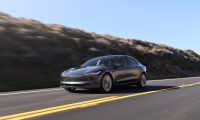Ford is using Google's Pediction API to advance research on how drivers behave for better use of vehicle control systems and to enhance fuel and electric efficiency. According to Ford, Google's Prediction API provides greater computation power, information storage and external data through cloud computing. It converts the data that gets input to predict a driver's behavior.
For example, if the system knows your making a heavy stop-and-go morning commute, it's going to conserve electrical power in your hybrid for when you need it most. It's also going to know that the time of day you are driving requires different energy use. So, a trip home from work at 9 p.m. is going to be less demanding than a 5 p.m. trip.
This week, Ford researchers presented a conceptual case of how the Google Prediction API could alter the performance of a plug-in hybrid electric vehicle at the 2011 Google I/O developer conference. In this theoretical situation, here’s how the technology could work:
• After a vehicle owner opts in to use the service, an encrypted driver data usage profile is built based on routes and time of travel. In essence, the system learns key information about how the driver is using the vehicle.
• Upon starting the vehicle, Google Prediction will use historical driving behavior to evaluate given the current time of day and location to develop a prediction of the most likely destination and how to optimize driving performance to and from that location.
• An on-board computer might say, “Good morning, are you going to work?” If the driver is in fact going to work, the response would be, “Yes,” and then an optimized powertrain control strategy would be created for the trip. A predicted route of travel could include an area restricted to electric-only driving. Therefore, the plug-in hybrid could program itself to optimize energy usage over the total distance of the route in order to preserve enough battery power to switch to all-electric mode when traveling within the EV-only zone.
An important aspect of the new system is the driver can opt in, which apparently means a driver can opt out. Google would only know where you are going if you want to tell it. Of course, the little black box in your vehicle is still going to be recording lots of information about your driving habits whether you want to opt into it or not because you have no choice.
“The Google Prediction API allows us to utilize information that an individual driver creates over time and make that information actionable,” said Ryan McGee, technical expert, Vehicle Controls Architecture and Algorithm Design, Ford Research and Innovation. “Between Google Prediction and our own research, we are discovering ways to make information work for the driver and help deliver optimal vehicle performance.”
“Ford already offers cloud-based services through Ford SYNC®, but those services thus far have been used for infotainment, navigation and real-time traffic purposes to empower the driver,” said Johannes Kristinsson, system architect, Vehicle Controls Architecture and Algorithm Design, Ford Research and Innovation. “This technology has the potential to empower our vehicles to anticipate the driver's needs.”











